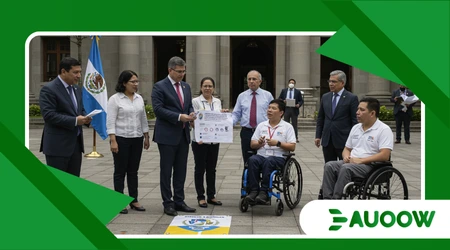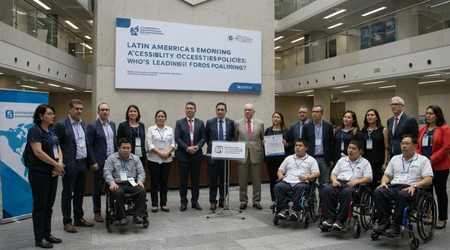Latin America’s Emerging Accessibility Policies: Who’s Leading?

Accessibility is no longer a fringe consideration; it’s a fundamental human right and a core economic imperative. Across the Southern Hemisphere, a quiet revolution is taking place as nations strengthen their legal frameworks to ensure full inclusion for people with disabilities.
Analyzing Latin America’s Emerging Accessibility Policies reveals a region moving past mere legislation toward concrete implementation and enforcement. This transition is vital given the significant portion of the population that requires accessible infrastructure and technology.
This detailed analysis examines which countries are genuinely leading this charge, distinguishing between aspirational laws and impactful, measurable outcomes.
We dissect key policies spanning digital inclusion, urban mobility, and educational integration. Understanding these policy movements provides crucial insight into the region’s commitment to equity and its future economic potential.
Why Is Digital Accessibility Crucial for Regional Development?
In the 21st century, access to information and public services largely occurs online. Therefore, digital exclusion is a massive barrier to economic participation and civil rights.
What Global Treaties Guide Latin American Policy?
Most Latin America’s Emerging Accessibility Policies stem from the ratification of the United Nations Convention on the Rights of Persons with Disabilities (CRPD). This treaty sets the global standard for inclusion.
By adopting the CRPD, countries commit to ensuring persons with disabilities enjoy all human rights and fundamental freedoms. This commitment necessitates concrete legislative and administrative actions, particularly in technology and communication.
The regional leadership understands that true compliance demands moving beyond simply passing laws to funding and enforcing technical standards.
++ How U.S. Federal Agencies Are Enforcing Web Accessibility in 2025
How Are Web Standards Being Adopted Across the Region?
The gold standard for web accessibility is the Web Content Accessibility Guidelines (WCAG), developed by the World Wide Web Consortium (W3C). Several Latin American countries are now legally mandating specific WCAG levels for all public sector websites.
Mandating WCAG adherence ensures that government portals, educational resources, and health services are usable by screen readers and alternative input devices.
This digital inclusion is essential for civil participation. Failing to enforce these standards negates much of the progress reflected in Latin America’s Emerging Accessibility Policies.

Which Countries Are Leading in Policy Innovation?
While many nations have updated their laws, two countries stand out for their comprehensive approach and institutional commitment to implementation.
Why Is Chile a Leader in Urban and Mobility Accessibility?
Chile has consistently pushed the envelope in creating tangible, physical accessibility across its major urban centers. Their focus is on the practical realities of daily life.
Also read: Monitoring Misinformation: The Role of Google Trends in Public Policy Research
The Chilean Law on Inclusion (Law 20.422) and Its Impact
Chile’s comprehensive Law 20.422 (passed in 2010 but continually updated) mandates accessibility standards for public spaces, transport, and infrastructure. Critically, it includes a robust system of fines for non-compliance.
This law ensures that new construction projects must integrate ramps, tactile paving, and accessible restrooms from the initial design phase. Santiago’s public transit system, the Metro, is often cited as a regional model for its physical accessibility features. This is a practical outcome of strong Latin America’s Emerging Accessibility Policies.
The focus on public transport is paramount. Analogy: Accessible public transit is the economic equivalent of a ramp into the job market. Without it, the opportunity remains unreachable, regardless of skill or talent.
Read more: The Americans with Disabilities Act (ADA) at 35: Achievements and Gaps
How Is Brazil Driving Digital Inclusion via Regulation?
Brazil, leveraging its massive digital market, has implemented stringent regulations to ensure digital platforms are inclusive. Their legislation is notable for its broad scope.
The Brazilian Law of Inclusion of Persons with Disabilities (Law 13.146/2015) directly mandates that all public and private websites with operations in Brazil must meet stringent accessibility criteria.
The policy’s enforcement applies to businesses of all sizes, making it a powerful mandate. The sheer scale of Brazil’s economy makes this a major policy driver for all of Latin America’s Emerging Accessibility Policies.
Addressing the Policy Gaps: Enforcement and Funding
The greatest challenge facing Latin America’s Emerging Accessibility Policies is the gap between the law as written and its daily reality on the ground.
Why Does Implementation Often Lag Behind Legislation?
Legislation is only as effective as the budget and institutional will supporting it. Many excellent laws fail due to inadequate government funding for training, monitoring, and enforcement bodies.
The Funding Deficit in Public Works
Retrofitting older infrastructure historic buildings, established transit systems requires immense capital investment. Without dedicated, multi-year funding streams, these projects stall, leaving policy goals unmet.
Lack of political continuity means that accessibility initiatives often lose priority with changes in administration. This instability is a major hurdle for sustained progress. True leadership is demonstrated by consistent budget allocation.
Example: In Mexico City, while the Metro is legally required to be accessible, many older stations still lack functional elevators or tactile pathways. The policy exists, but the necessary large-scale, sustained infrastructure investment is missing.
The Role of Educational Policy in Long-Term Inclusion
Accessibility policies must extend into the educational system to foster future economic participation. Integrating students with disabilities requires teacher training, specialized resources, and inclusive curricula.
Without dedicated investment in inclusive education, the next generation will still face systemic employment barriers. Education is the pipeline for fully realizing the economic potential unlocked by Latin America’s Emerging Accessibility Policies.
Data Insight: According to a 2023 Inter-American Development Bank (IDB) report on social inclusion, the average employment rate for persons with disabilities across five major Latin American economies was 25% lower than the general population. This stark disparity underscores the failure of current policies to translate into economic opportunity.
Key Policy Frameworks and Enforcement Metrics
| Country | Key Policy/Law | Primary Focus Area | WCAG/Digital Mandate? | Current Implementation Score (Est. 1-5) |
| Brazil | Law 13.146/2015 (Inclusion) | Digital and Public Services | Yes (Strict Adherence) | 4 |
| Chile | Law 20.422 | Urban Mobility and Transport | Yes (Growing Mandate) | 4.5 |
| Argentina | Law 26.378 (CRPD) | Educational and Public Administration | Moderate (Focus on Public Sector) | 3 |
| Colombia | Law 1618/2013 | Non-Discrimination and Access | Moderate (General Mandate) | 3.5 |
Conclusion: The Path from Pledges to Participation
The trend is clear: Latin America’s Emerging Accessibility Policies are improving, moving from patchwork efforts to comprehensive, rights-based frameworks inspired by the CRPD.
Nations like Chile and Brazil are demonstrating that policy can drive physical and digital change, but the journey is far from complete.
The greatest current test is transitioning from the legal promise to the lived reality funding retrofits, strengthening enforcement, and ensuring continuous political will.
The progress is encouraging, yet the IDB data is a stark reminder of the work ahead. We must continue to ask: Is this policy actually removing the barriers to employment and independent living?
Which specific digital accessibility feature has made the biggest difference in your daily life? Share your thoughts below!
Frequently Asked Questions (FAQ)
Q: What is the biggest hurdle to fast-tracking accessibility in Latin America?
A: The biggest hurdle is the infrastructure legacy gap. Most urban centers have historical infrastructure predating modern standards. Retrofitting old subways, sidewalks, and government buildings requires massive, sustained public spending, often competing with other urgent social needs.
Q: Does digital accessibility apply only to government websites?
A: No. While government sites are usually the first legally mandated, the scope of Latin America’s Emerging Accessibility Policies increasingly extends to private sector entities that offer public services or have significant public interaction, particularly in finance, education, and health.
Q: How can I check if a website in Latin America is accessible?
A: While you can use free online tools that check for basic WCAG compliance, the best check is to try navigating the site using only the keyboard (no mouse) and using a screen reader simulation. If you can’t complete the main tasks easily, the policy is likely being violated.
